-
Posts
2,335 -
Joined
-
Last visited
-
Days Won
12
Content Type
Profiles
Forums
Blogs
Gallery
Events
Store
Posts posted by Bear
-
-
Hello,
I just got this one.
 This doc has to rate as one of my favorites.
This doc has to rate as one of my favorites.thanks,
barry
James Monroe(1758 - 1831)
Fifth President of the United States who negotiated the Louisiana Purchase and promulgated the Monroe Doctrine. Rare partly-printed D.S. "Jas. Monroe" as Minister Plenipotentiary of the United States to the French Republic, 1p. folio, Paris, May 6, 1796, a diplomatic passport issued to Silvanus Bourne, U.S. consul at Amsterdam, countersigned by French Foreign Minister CHARLES-FRANCOIS DELACROIX (1741-1805). Delacroix served as foreign minister from 1795 to 1797. Monroe served as ambassador from 1794 to 1796 where he struggled to reconcile his own sympathy for the French Revolution with the Washington administration's strict policy of neutrality toward both Britain and France. Silvanus Bourne was the first to man the American consulate at Amsterdam. Appointed in 1794, he remained at his post until his death in 1817.
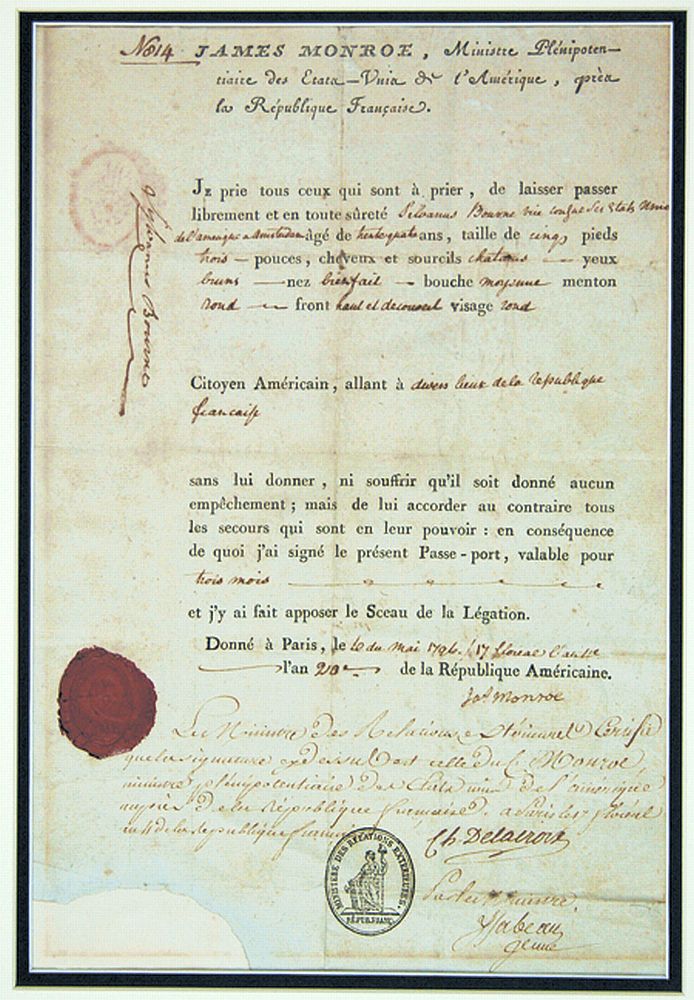 0
0 -
It might be the same person. Everywhere I look he has different intials.
An Example: When I've gone through the old papers looking for French Marshal Lannes(Lannes, Lannas, Lonnas, Lasnes, Lanne, Lanse, ect...) and that's the French Papers. You would think that they would have got his name right.
Henry Thomas Shaw
H. E. Shaw
R. Henry Shaw
0 -
Google Books
The Battle of Waterloo
http://books.google.com/books?id=k4dJAAAAM...qPxNovKNdv-tYUC
Notice the note at the bottom of the page.
0 -
I would guess that the officer in the miniature portrait is Captain Henry Thomas Shaw.
Lt. Col. Henry Thomas Shaw(21 Feb 1788/ 20 June 1832)
Admiral Sir George Cockburn(1772-1853) was given the credit for burning down the White House. I just can't see a British Captain running around with a torch. A very ungentlemanly act. Maybe orders down the chain Admiral to Colonel to Major to Shaw to Lt. to Sargent to Corporal to Private. But then again maybe he did torch it.
Battle of Waterloo/ List of Officers
4th Foot
Lt. Col. F. Brook
Captains
Capt. H. T. Shaw
Wilson
Edgell
Wood
Fletcher
Erskine
Craig
Kirwan
Browne
0 -
Battle of New Orleans
Names of Officers killed, wounded, and missing, in the action of the 8th of January 1815.
Capt. H.E. Shaw, 4th Foot (British Marines) (slightly wounded)
another pub. listed as
Capt. Henry Thomas Shaw 4th Foot (Brigade Major) (slightly wounded)
another pub.
History of the war in France and Belgium, in 1815
List of Captains in the 4th Foot
4th Foot - Lt. Col. F. Brook
4th Foot - Capt. H. T. Shaw
remaining Captains in the 4th in 1815
Wilson
Edgell
Wood
Fletcher
Erskine
Craig
Kirwan
Browne
September 1825
Major Shaw, 4th Foot, to be deputy quartermaster-general in the Windward and Leeward Islands, with rank of Lt. Col. in the army
0 -
Hello les,
Post it along with anything else you have on him.
0 -
I'll have to see if I can find any info on Joseph Dupar. I have a print of the Marqui but its not as nice as the picture on wikipedia.
 0
0 -
I've been waiting along time for a document like this one signed by Lafayette. Since I started collecting I've kept an eye out for one of his documents. The ones that pop up are always dated in th 1820's, which just isn't the same as the one that came knocking.
The document is signed as commander of the Paris National Guard and dated the 1st of September 1789. This was just six weeks after the stroming of the Bastille. The document is a commission to Lieutenant in the Paris National Guard.
Commission for Second Lieutenant, First Division, Fourth Battalion, Dequet Company, Paris National Guard. We, Mayor of the city of Paris, with consideration to the motion put to us by the Commander-General of the Parisian National Guard and to the favorable testimony given us of the patriotic ardor, of the intelligence and of the good behavior of one Joseph Dupar, former Sergeant?we?appoint him Second-Lieutenant?to fulfill the duties attached to that rank, and enjoy all honors, rights, remuneration and emoluments attached to that rank?Executed in the Paris City Hall, September the First, seventeen hundred eighty-nine?.
The document is also signed by -
Paris mayor Jean Sylvain Bailly (1736-1793)
Joseph-Leonard Poirey who was Lafayette's aid during the American Revolution.
Wikipedia
http://en.wikipedia.org/wiki/Gilbert_du_Mo...is_de_Lafayette
Lafayette spoke for the last time in the Chamber of Deputies on 3 January 1834. The winter was wet and cold, and the next month he collapsed at a funeral from pneumonia. Although he recovered, the following May was wet and, after a thunderstorm, he became sick and bedridden. On 20 May 1834, Lafayette died. He was buried next to his wife at the Cimeti?re de Picpus under soil from Bunker Hill, which his son Georges sprinkled upon him. King Louis-Phillipe ordered a military funeral in order to keep the public from attending. Crowds formed to protest their exclusion from Lafayette's funeral.
American President Andrew Jackson ordered that Lafayette be accorded the same funeral honours as John Adams and George Washington. Therefore, 24-gun salutes were fired from military posts and ships, each shot represented a U.S. state. Flags flew at half mast for thirty-five days, and "military officers wore crape for six months". The Congress hung black in chambers and asked the entire country to dress in black for the next thirty days.
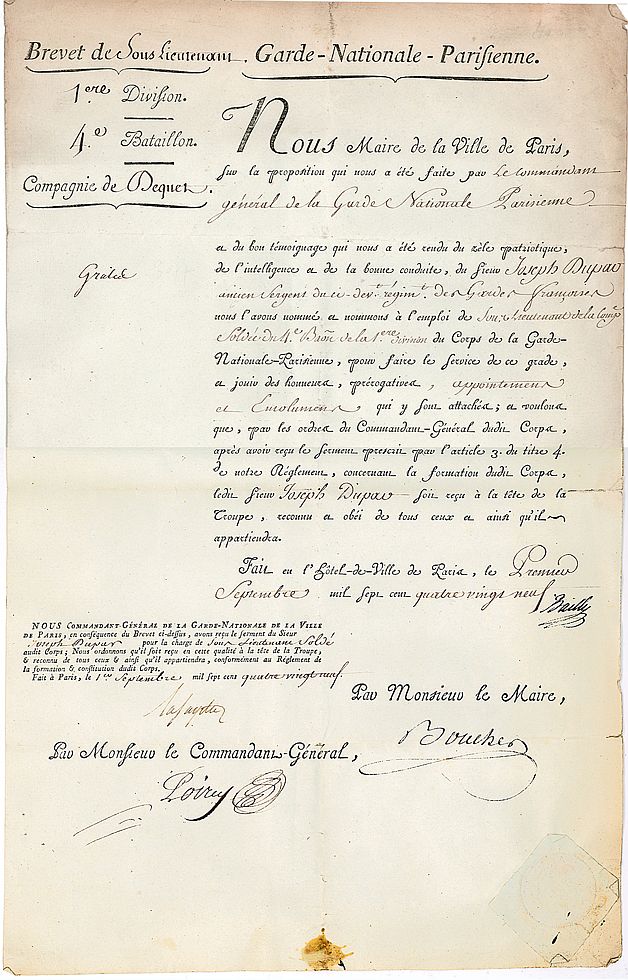 0
0 -
Are you sure it's the 4th and not the 44th. Or maybe a typo.
I found this fella at Waterloo.
Captain Jason Shaw - 44th Foot
R Shaw :speechless:
0 -
This print shows three medals
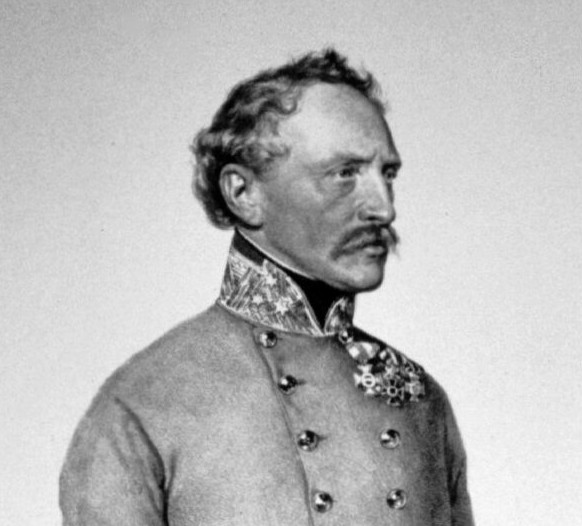 0
0 -
Wikipedia
http://de.wikipedia.org/wiki/August_von_Degenfeld-Schonburg
August Franz Johann Christoph Graf von Degenfeld-Schonburg (auch Schomberg; * 10. Dezember 1798 in Gross-Kanicsa (Nagykanizsa), Ungarn; ? 5. Dezember 1876 in Altm?nster bei Gmunden) war ein ?sterreichischer Feldzeugmeister.
Degenfeld-Schonburg war ein Spross des Adelsgeschlechts der Grafen von Degenfeld-Schonburg und Urenkel des preu?ischen Kriegsministers Christoph Martin II. von Degenfeld (1689-1762). Er nahm am Feldzug 1815 als Offizier der Infanterie teil, wurde 1835 Major und war mehrere Jahre Adjutant beim Generalkommando in B?hmen. 1848 f?hrte er als Generalmajor eine Brigade und war 1849 wirksam an der Schlacht von Novara beteiligt.
Im Oktober 1849 wurde Degenfeld-Schonberg zum Feldmarschallleutnant bef?rdert. Er war danach zun?chst Vizegouverneur von Mainz, 1850 wurde er Sektionschef im Kriegsministerium. Kaiser Franz Joseph zog ihn 1852 zur Dienstleistung heran, bevor er 1855 Kommandeur des 8. Armeekorps wurde. Im Italienischen Krieg 1859 erhielt er als kommandierender General das Oberkommando im K?stenland.
Im Oktober 1860 wurde Degenfeld-Schonberg zum Feldzeugmeister und Kriegsminister ernannt, legte aber 1864 sein Amt aus Gesundheitsgr?nden nieder. W?hrend des Deutschen Krieges 1866 trat er vor?bergehend wieder in den aktiven Dienst ein und vereinbarte am 26. Juli 1866 die Waffenstillstandskonvention von Nikolsburg.
August Graf von Degenfeld-Schonburg starb am 5. Dezember 1876 in Altm?nster bei Gmunden.
Nach Feldzeugmeister Degenfeld-Schonburg wurde ein ?sterreichisches Festungswerk im damaligen Welschtirol benannt. Es liegt auf einem Bergr?cken oberhalb der Ortschaft Piovezzano ?stlich der Autobahn Trient - Verona etwa auf der geografischen H?he von Lazise. Auf italienischen Karten ist es als ?ex Forte Degenfeld? ausgewiesen.
Wiki Photo
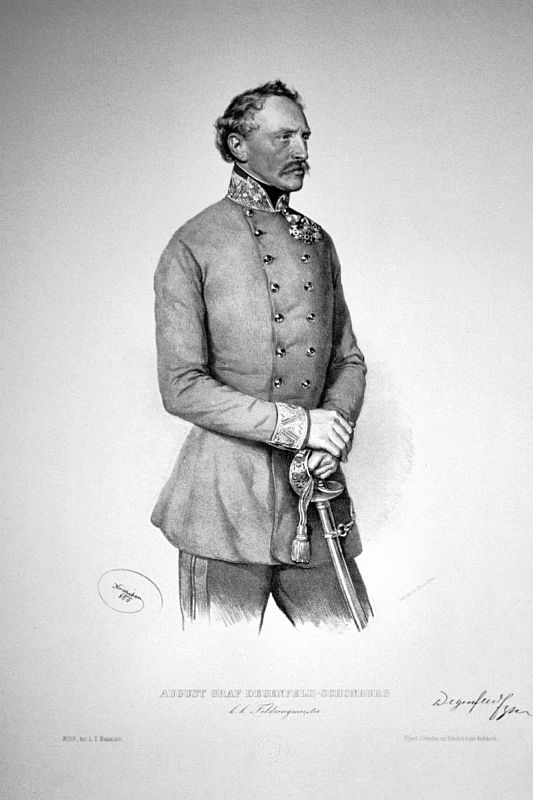 0
0 -
If I had any money I'd put it on this guess. Anton served under General Kruse at Waterloo. This brigade was stationed at the Ch?teau d'Hougoumont(farmhouse) and took heavy casualties on the 18 of June 1815. I believe this is where Anton was wounded.
The only problem with this guess is that the Nassua soldiers at the farmhouse was commanded by Captain B?sgen and Anton was a major. However the Captain was an infantry officer while Anton was an engineer. I think Anton was sent along with brigade not to command but to check the fortication.
The only place an engineer could have been used at Waterloo would have been the farmhouse.
Breidbach-Bűrresheim, Major ? la suite Anton Philipp von; Adjutant-Volunteer Nassau contingent; wounded 18 June 1815 (1791- )(KB No.7, 25 February 1816)
0 -
Geschichte der K. Und K. Technischen Milit?r-akademie By Friedrich Gatti
Eingetheilt am 24. Sept. Kostgeben p.r. 520 fl. Am 9 Mai 1809 F?hnrich im Inf. Reg. Gyulai (Nr. 60)
Eingetheilt on 24 Sept. Kostgeben p.r. 520 fl. On May 9, 1809 Ensign in Inf Reg Gyulai (No. 60)
Their were two General Gyulai who fought in 1809. One in Italy and one in Austria.
I wonder if he participated in any action during 1809.
The 1809 campaign is my FAVORITE.
 0
0 -
Just too many from Nassau.
 Where are you in this mess.
Where are you in this mess. 
Nassau at Waterloo
Nassau Contingent - Major-General A.H.E. von Kruse - 2,880
1st (Duke of Nassau) Infantry Regiment - Colonel Ernst von Steuben
1st Battalion / 1st (Duke of Nassau) Infantry Regiment - Major Wilhelm von Weyhers
2nd Battalion / 1st (Duke of Nassau) Infantry Regiment - Major Adolph von Nauendorf
2nd Nassau Regiment - Major Friedrich Sattler - 2,709
1st Battalion / 2nd Nassau Regiment - Captain B?sgen
2nd Battalion / 2nd Nassau Regiment - Major Philipp von Normann
3rd Battalion / 2nd Nassau Regiment - Major Gottfried Hegmann
Regiment of Orange-Nassau - Colonel The Duke of Saxe-Weimar - 1,591
1st Battalion / Orange-Nassau Regiment - Lieutenant-Colonel W. Ferdinand von Dressel
2nd Battalion / Orange-Nassau Regiment - Lieutenant-Colonel Philipp Schleyer
1 Company Nassau Volunteer J?gers - Captain E. Bergmann
0 -
It seema that this fella picked up his commission at the worst possible time. The 1809 Austrian campaign was a hard fought war for both the French & Austrians.
0 -
De Militaire Willemsorde (MWO)
(?Military Order of William?)
RIDDER VIERDE KLASSE (?4TH CLASS KNIGHT?)
http://home.wanadoo.nl/g.vanuythoven/MWO/M...4th%20Class.htm
Breidbach-Bűrresheim, Major ? la suite Anton Philipp von; Adjutant-Volunteer Nassau contingent; wounded 18 June 1815 (1791- )(KB No.7, 25 February 1816)
0 -
The German readers can go through this list of books.
Leben des Freiherrn Max von Gagern 1810-1889 By Ludwig Pastor
http://books.google.com/books?id=tkMKAAAAI...mqDw&pgis=1
Hochzeit feiner Schwester Amalie mit dem Freiherr? Anton von Breidbach? ...
bei Waterloo gek?mpft hatten
Wedding sister Amalie fine with the Baron "by Anton Breidbach? ...
fought at Waterloo
Mise ? mort de l'Empire par Napol?on By Jean Pierre de Potter
http://books.google.com/books?id=HdFnAAAAM...nRBg&pgis=1
Adjutants Volontaires
Google Books
search - Breidbach waterloo
http://books.google.com/books?ei=nfwFSp-GO...nG=Search+Books
0 -
Nobles and Nation in Central Europe
pages 114-115
Though Anton went on to the Hapsburg military-engineering academy and in 1809 received a commission, a Napoleonic decree soon compelled subjects of the states of the Confederation of the Rhine to withdraw from Austrian service or suffer confiscation of their estates. Anton then returned to Nassau, where several decades later he reached the rank of general.
Google Books
Nobles and Nation in Central Europe
pages 113, 114?15, 116
http://books.google.com/books?id=fkBUgPQwE...MnXDw#PPA116,M1
I'll keep looking :D
0 -
Looks like you'll need to buy a book.
 I'll check Google Books to see if its online.
I'll check Google Books to see if its online.Nobles and Nation in Central Europe
Free Imperial Knights in the Age of Revolution, 1750?1850
Index List the Baron on these Pages
Breidbach-Riedt, Baron Anton (1791?1878) 113, 114?15, 116
 0
0 -
One tends to forgot the price that animals pay in war.
The Exploits of Baron de Marbot
p. 104/5
Tudela, Spain 1808
During this affair I had a lively quarrel with Labedoyere over the following matter. He had just bought a young and ill broken horse, which at the sound of the cannon reared up and absolutely refused to go on. Labedoyere leaped off in a rage, drew his sword, and hamstrung the poor beast, who fell bleeding on the grass, dragging himself along by his forefeet. I could not contain my indignation, and expressed it to him in strong terms; but Labedoyere took it very ill, and we should have come to blows had we not been in the presence of the enemy. The report of this incident got about in the staff and Marshal Lannes, very angry, declared that he would not have Labedoyere any more among his Aides-de-Camp. The latter, in despair, had seized his pistols to blow out his brains, when our friend de Viry suggested to him that it would be more honourable to seek death in the ranks of the enemy than to inflict it upon himself.
0 -
A nice French & Indian War Massachussetts commission with an early mention of Artemas Ward.
FRANCIS BERNARD, Esq;
Captain General and Governor in Chief, in and over His Majesty?s Province of the Massachusetts-Bay in New-England, and Vice-Admiral of the Same
(Signed)
Fra Bernard
To Aaron Warren Gent. Greeting. By Virtue of the Power and Authority in and His Majesty?s Royal Commission to Me granted to be Captain General, over this His Majesty?s Province of the Massachusetts Bay aforesaid I do by those Presents(reposing especial Trust and Confidence in your Loyalty Courage and good Conduct) constitute and appoint You the Said Aaron Warren Ensign of a military Company of Foot in ye Town of Upton, whereof Ezra Wood is Captain, and in the Regiment of Militia in the county of Worcester, whereof Artemas Ward Esq. is Colonol. You are therefore carefully and diligently to discharge the Duty of a Ensign in leading, ordering and exercising said Company in Arms both inferior Officers and Soldiers and to keep them in good Order and Discipline and they are hereby commanded to obey you as their Ensign and you are your self observe and follow such Orders and Instructions as you shall from time to time receive from your Captain, or other your Officers according to military Rules and Discipline, to the Trust reposed in you. Given under my Hand and Seal at Arms at Boston, the first Day of July In the Second Year of the Reign of His Majesty King GEORGE the THIRD, Annoq; Domini, 1762
By His Excellency?s
Command,
(Signed)
John Cotton
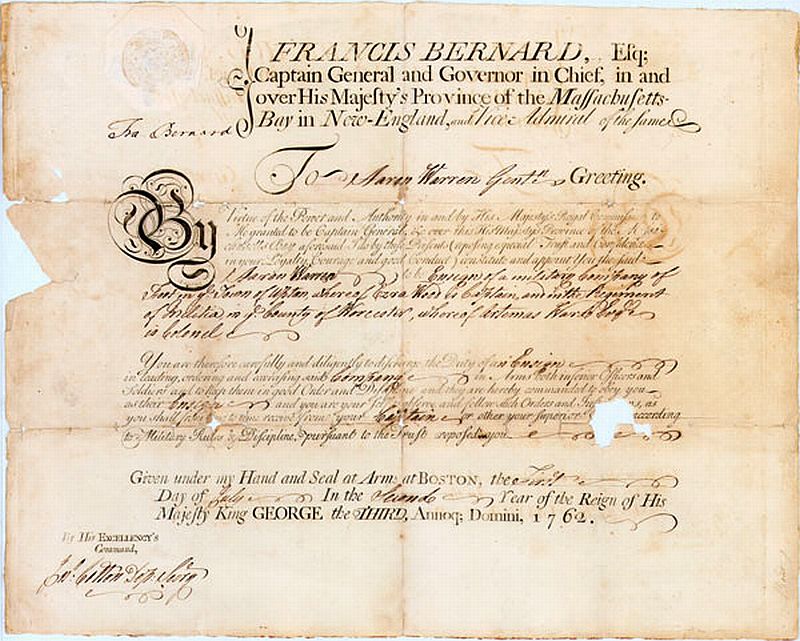 1
1 -
The French lost an estimated 50,000 horse during the Russian Campaign of 1812. When Napoleon returned to France one of his biggest problems was finding horses to replace all those lost. I imagine that the Germans by 1944 must not have had many horses left(Just a Guess). Maybe the vets were placed in combat positions to fill in the officer ranks.
Some info on horses in WWII
http://warandgame.wordpress.com/2008/02/26...n-army-in-wwii/
Consider the vaunted Wehrmacht, whose pride was the mechanized might of the panzers. When Hitler invaded Russia on June 22, 1941, the German Army had over 750,000 ?hippotrain? (horse-drawn) guns and other vehicles, in contrast to only about 600,000 motor vehicles, including some 3,500 armored fighting vehicles. Aside from the operational limitations that the use of horses and mules imposed on the German Army, they also proved an enormous logistical burden. On average, to feed three horses doing useful work hauling howitzers and such required the services of two more horses to haul their weekly rations of feed and fodder. And since horses and mules are not as sturdy as cars and trucks, during the war on the Eastern front the German Army lost an average of 1,000 horses a day. About 75 percent of these losses were due to combat, 17 percent to heart failure brought on by overwork, and the balance, 8 percent, to diseases, exposure, and starvation. Replacing horses was a major problem. Nevertheless, since the Germans had an inadequate supply of motor vehicles, they continued to rely on horseflesh through the entire war. The total number of horses used by the German armed forces during the war is unknown, but losses appear to have totaled about 2.7 million, nearly double the 1.4 million that were lost in World War I. This includes animals killed for food: Unlike wrecked trucks, dead horses could be eaten, and this was done regularly by Germans and Russians alike.
0 -
Fantastic Photo!
It looks like Stabsveterin?r Dr. Wilner has an EKI, which possibly means he did a little more that his vet duties.
thanks,
barry
0 -
Thanks for the HELP

I'm not sure that he can be identified as a Major. If he was a colonel with a regiment number we might be able too.
WELL CRAP




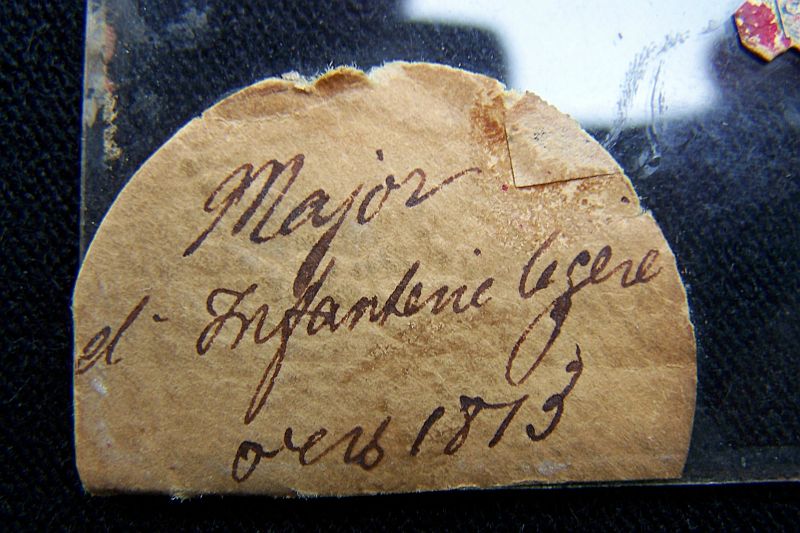 0
0




Napoleonic Documents
in France
Posted
During this time Monroe was serving in President George Washington's administration. The document is signed just four days before Napoleon won at Lodi in the Italian Campaign. During the American Revolution Monroe served as a 2nd Lt. in the 3rd Virginia. He would be wounded at the Battle of Trenton.
Wikipedia Photo